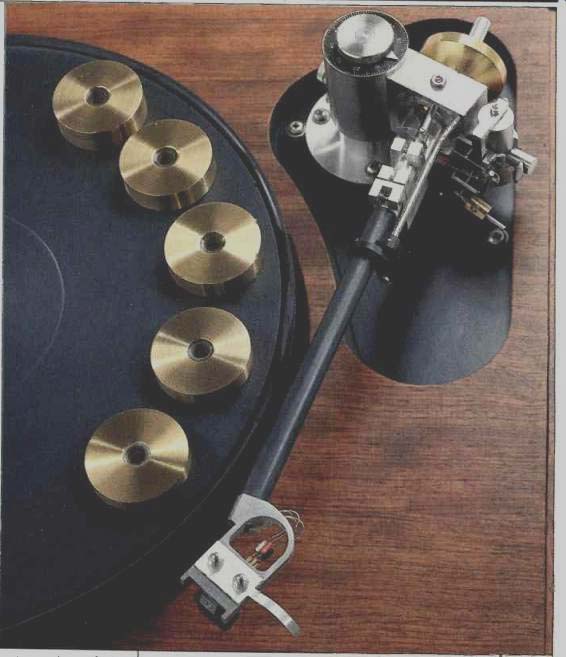
Manufacturer's Specifications:
(Note: Measurements of arm taken when fitted with Accuphase Model AC 2 phono cartridge.)
Tonearm Resonance: Vertical, 7 Hz; lateral. 7 Hz.
Top Resonance: Vertical, 12 dB; lateral, 11 dB.
Tracking Ability: Left channel, 80 um; right channel, 80 um.
Price: $1.795.
Company Address: 11230 Grand view Ave., Wheaton, Md. 20902.
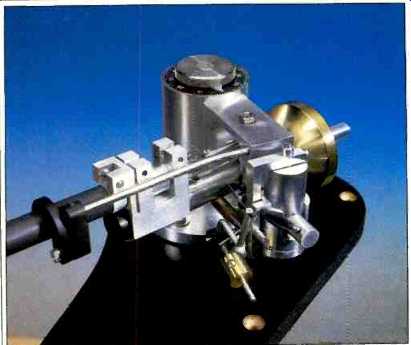
The Wheaton Tri-Planar II is the latest version of the tonearm designed and handcrafted by Herbert Papier, who began making it in 1981. Various refinements have been incorporated to increase the level of performance, which was already considered by many experts to be excellent.
Wheaton Music is not a hi-fi store but a music store, the kind that specializes in helping people produce their own live sound by providing musical instruments and sheet music. Before starting Wheaton Music, Papier was a watch maker. As such, he was used to working with tiny precision parts. When he retired a few years ago, Papier decided to design and build a tonearm for himself, and his experience in watch-making gave him a definite advantage when it came to the most critical part of a tonearm, the bearings.
When others saw and heard the results of his efforts, they encouraged Papier to produce the tonearm commercially.
With the collaboration of Steve McCormack of The Mod Squad (a company which specializes in custom improvements in high-end audio products), refinements were made in the tonearm. The name Tri-Planar was given to the tone arm because it reflects the design emphasis of allowing proper adjustment in three planes: The tonearm vertical bearings in relationship to the record surface, the vertical tracking angle of the phono stylus, and the azimuth of the phono stylus with respect to the side walls of the record groove.
The first things I noticed about the Tri-Planar II tonearm were the large number of machined aluminum parts (some of which are quite small) and the high quality of the natural finish. It is obvious that a great deal of hand work is involved in its production. The main or upper armtube is covered with heat-shrink tubing-a very clever touch that should help damp out resonances. The use of two arm-tubes, one above the other and connected by a machined block of aluminum, also caught my eye. While this is certainly unconventional, it was necessary if one of the design goals-to place the vertical bearings at the same height as the record surface was to be achieved. A dial on the top of the tonearm pillar has 100 very clear, white-on-black markings, which are divided into groups of five and labeled every 10 divisions. A knurled knob in the center of the dial is used to set the vertical tracking angle.
When I grasped the armtube firmly in one hand and the main pillar in the other, and exerted force in different directions, I found that the bearings exhibited no looseness or play. They were, in fact, practically frictionless in the vertical and horizontal directions, which is as it should be. The designer's attention to detail is also apparent in the knurled-head ground screw on the base of the tonearm, which allows a separate ground wire to be attached if necessary. I was also very favorably impressed by the care taken in dressing the lead wires from the upper tonearm tube, through the bottom tube, and out to the connector block (which has gold-plated phono sockets and a gold-plated, five-way ground terminal). Mounting the Tri-Planar II tonearm is relatively easy. It needs no center hole for the pillar, and it is fastened to the turntable mounting board with three screws. Since the pillar does not extend below the mounting board, the Tri-Planar is ideal for shallow turntables. For this report, I decided to use the Shure V15 Type V-MR cartridge, which proved to be an excellent match with the Tri-Planar II.
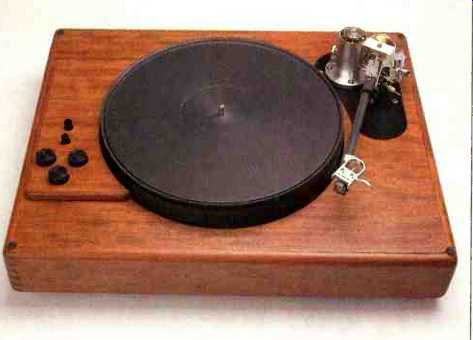
Tonearm designers know that vertical bearings should be located on the same plane as the record surface, to allow for record warps. When the vertical bearings are above the record surface--as they are in most designs--the phono stylus will move back and forth in the groove as it follows the record warp up and down. This motion changes the wave lengths of the musical signals, making them shorter with forward motion of the stylus and longer with backward motion. Sonically, this translates as pitch changes which vary in direct relationship to the frequency and severity of the warps in the record. Vertical bearings in a tonearm are necessary, therefore, because all records tend to have some surface unevenness. It is interesting to speculate that if records were perfectly flat and of uniform thickness, no vertical bearings would be required at all. Such a tonearm's pillar could be raised and lowered to allow records to be changed.
================
MEASURED DATA
Wheaton Tri-Planar II Tonearm:
Pivot-to-Stylus Distance: 9.85 in. (250.2 mm).
Pivot-to-Rear-of-Arm Distance: 2.25 in. (57.2 mm).
Overall Height Adjustment: 0.75 in. (19 mm); 1/40 in. for each vernier rotation.
Tracking-Force Adjustment: Set by counterweight.
Tracking-Force Calibration: None (use external gauge).
Cartridge Weight Range: 4 to 20 grams.
Counterweights: Two main (99.9 and 112.8 grams) and five secondary (69.6, 85.7, 101, 118, and 136.5 grams).
Counterweight Mounting: Soft polyurethane insert.
Sidethrust Correction: Adjustable thread and weight.
Pivot Damping: Viscous.
Lifting Device: Damped lever and finger lift on headshell.
Headshell Offset: 22.0°.
Overhang Adjustment: Slots in headshell.
Bearing Alignment: Excellent.
Bearing Friction: Less than 40 milligrams.
Bearing Type: Hardened steel point and ball races
Lead Torque: Negligible.
Arm-Lead Capacitance: 35 pF for left and right channels.
Arm-Lead Resistance: 1.1 ohm for left and right channels.
External Lead Length: None supplied (gold phono jacks).
Structural Resonances: See Fig. 7.
Base Mounting: Three screws through base; no pillar hole needed.
Shure V15 Type V-MR Cartridge:
Coil Inductance: 350 mH.
Coil Resistance: 875 ohms.
Output Voltage: 0.48 mV/cm/S.
Tracking Force: Without damping brush, 1.3 grams; with damping brush, 1.9 grams.
Cartridge Mass: 6.8 grams.
Microphony: Very good.
Hum Rejection: Excellent.
High-Frequency Resonance: 32.3 kHz.
Rise-Time: 18 FIS.
Low-Frequency Resonance: Without damping brush, 5.5 Hz and Q = 7.9; with damping brush, 8.0 Hz and Q = 1.2.
Recommended Load Resistance: 47 kilohms.
Recommended Load Capacitance: 250 pF.
================
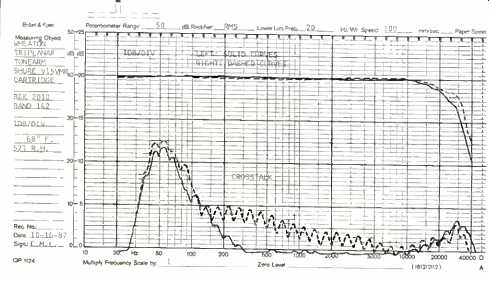
Fig. 1--Frequency response and crosstalk, Wheaton Tri-Planar II tonearm
with Shure V15 Type V-MR cartridge, using B & K 2010 test record.
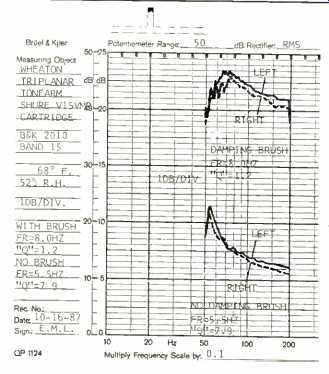
Fig.
2--Low-frequency resonance of the Wheaton/Shure combination. Using the cartridge's
damping brush (top curves), resonance is at 8.0 Hz and Q = 1.2; without damping
brush (bottom curves), resonance is at 5.5 Hz and Q = 7.9.
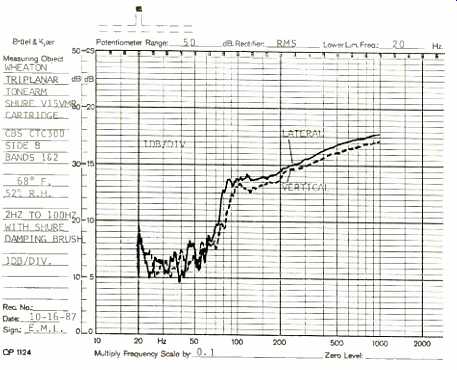
Fig. 3--Response to cartridge damping brush vertical and horizontal engaged
and using CBS modulation from 2 to CTC-300 test record. 100 Hz (slow sweep)
with Fig. 4-Same as Fig. 3 but without cartridge damping brush.
The vertical tracking angle (VTA) is the angle between the playback stylus and the record groove (as viewed from the side). It’s the relationship between the playback stylus and the groove shape formed by the angle of the original cutting stylus. There is more involved in VTA than this, of course, but much effort was spent in the 1960s to try and standardize record cutting as much as possible. (In fact, Shure's series of V15 phono cartridges began in this era.) Many factors militate against an exact adherence to the desired 15° angle. Records are cut by many different companies all over the world, using different cutting systems and stylii as well as different blank lacquer master discs. It is difficult to measure the cutting angle exactly, and variations exist in the "spring-back" or "memory" variations of the different plastic formulations used in making records. Therefore, the vertical tracking angle should be adjusted to achieve the best results from each record.
The Tri-Planar II tonearm provides a calibrated vernier adjustment for this purpose. Turning the knurled knob on top of the main pillar will raise or lower the tonearm bearing, which changes the VTA of the stylus. The calibrations on the dial are arbitrary, but they allow settings to be repeated after the best VTA for each record has been found and marked on the record jacket.
Improvement in the stereo qualities of a record--such as the spread of the sound (stage width) or the ability of a listener to localize sound sources (imaging)-can be quite dramatic when attention is paid to setting the stylus azimuth angle correctly. Since the stereo information in a record groove is completely contained in the vertical component of the groove modulation, the interfaces between the stylus contact areas and the groove walls should be mirror images of each other. Any difference will shift the angle of the vertical component of the force exerted by the moving groove on the stylus. Such tilting results in distortion of the stereo information. The Tri-Planar II tonearm has a provision for setting the azimuth angle very accurately. It is a feature which I find extremely valuable, because it allows for easily audible improvement over the more common method of making this adjustment with a mirror. A small hex-head screw is used to drive a pin on the top of the upper tonearm tube, causing the tube to rotate. Wheaton supplies a small screwdriver for this purpose, and the mechanical control that this provides makes exact adjustment relatively easy.
Wheaton recommends measuring the crosstalk output of the cartridge by using either of two commercial devices for making this adjustment--one of which they say is no longer available. I have neither device, so I used a different technique. The idea is to balance the vertical component of each channel, so I used a mono record (which, by definition, has only lateral modulation) and then connected the cartridge so that the channels were opposite in polarity. This yields a left-minus-right signal that is the vertical component of force. By turning the azimuth screw while listening to a mono record, the output can be cancelled almost completely, which means the crosstalk is balanced. Since all records are not exactly identical with respect to the VTA, I tried a number of mono records to see if variations among them would cause the crosstalk to vary. While variations were slight, the azimuth setting for minimum output-using the same cartridge-remained consistent, indicating that this technique is a viable alternative to the method recommended by Wheaton.
The machined aluminum headshell, which is firmly attached to the upper armtube, is supplied with a special dummy cartridge that includes a long, pointed shaft to simulate a stylus. I used this later to accomplish the preliminary alignment of the tonearm. A thin aluminum plate, with an extension formed as a finger lift, has two press-fitted nuts for the cartridge screws. The upper armtube is made of two concentric aluminum tubes with a damping layer between them, and the inner tube is filled with polystyrene cylinders, packed under slight pressure. Special mono-crystal wires travel down the center of the tube, terminating in gold plated connectors that slip over the cartridge pins. Plastic and lead damping is strategically placed inside the armtube to aid in damping resonances. The sidethrust or anti-skate correction is not calibrated, but it was not hard to set it for the optimum amount of force by listening. The horizontal and vertical pivots are ball-race types, with six tiny balls and a hardened steel point. The damped cueing system is very good, and the plastic sleeve on the cueing bar prevents the tonearm from sliding sideways when it is carefully lowered o the record.
Measurements and Listening Tests
A listening panel was used to evaluate the subjectively perceived sonic qualities produced by the Tri-Planar II tonearm and Shure V15 Type V-MR cartridge combination. The panel was also asked to compare the combination with a high-quality reference tonearm and cartridge system.
Although many experts consider the reference system to be the best available, I choose not to reveal the names of its components. I do not wish to convey the idea that I think hey are the best available. Its purpose is not to be viewed as the ultimate system, but rather to provide a consistent reference for the listening panel.

Fig. 5--Slow sweep from 20 Hz to 1 kHz. Note absence of glitches in this
range; their presence would indicate artifacts which would color sound quality.
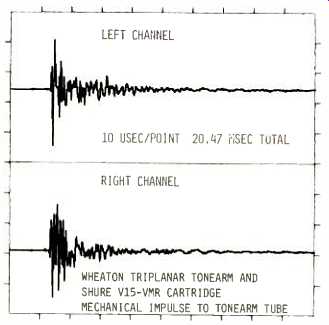
Fig. 6--Output vs. time of arm/cartridge when mechanical impulse was applied
to armtube.
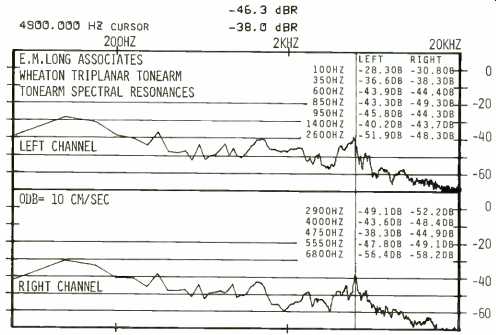
Fig. 7--Spectral output (averaged) of arm' cartridge due to 16 mechanical
impulses applied to armtube. Note the increase in output centered around
4.9 kHz.

Fig. 8--Interchannel phase difference. Perfect phase response would be a
straight 45° line; the Wheaton/Shure combination's response is close to perfection.
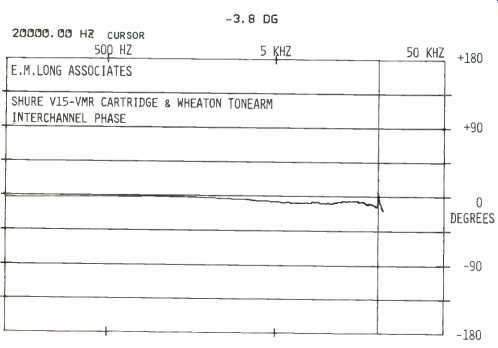
Fig. 9--Interchannel phase difference vs. frequency from B & K 2011,
band 7, pink noise. Phase difference at 20 kHz is 3.8° (less than 0.5 uS).
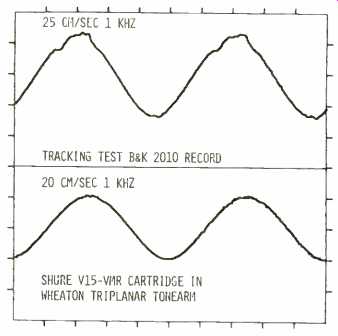
Fig. 10--Tracking test of Wheaton/Shure combination.
Mistracking seen in the top curve is of the highest level on the test record, and this should therefore be considered good performance.
The panel auditioned a number of recordings of different types of music. Each member was asked to rate the Wheaton/Shure combination and the reference system on a scale from 0 to - 5. They were also asked to write down comments about the quality of the sound that they heard. The listening panel's scoring for a total of 12 categories showed that the Wheaton/Shure combination tied the reference system in overall points. However, scoring and comments for each category showed that the preferences of the majority of panel members fluctuated between the two systems. Consequently, I've tried to correlate the panel's subjective impressions with the technical measurements to show the strengths and weaknesses of each combination.
Figure 1 shows the amplitude versus frequency response and the crosstalk of the Wheaton/Shure combination. The two channels show excellent balance from 20 Hz all the way to 20 kHz, and the low-frequency crosstalk is very good for this particular test record. That the Tri-Planar II tonearm allows for precise adjustment of the azimuth is certainly responsible for these results, and the comments of all panel members indicated that they rated the Wheaton/Shure combination superior to the reference system in spaciousness.
Figure 2 shows the low-frequency resonance caused by the mass of the Tri-Planar II and the compliance of the V15 Type V-MR. The Q is quite high when the cartridge's damping brush is not used. The use of a less compliant cartridge would move the resonance up in frequency, from 5.5 Hz, but the cartridge mass should also be kept low or the Q could be higher than desirable for good low-frequency performance. The sound is much better when the Shure's damping brush is activated, but the low-frequency performance of the reference system was preferred by a majority of the listening panel. They found, for instance, that the sound of double bass was "well defined" and "clearer" and that drum sound was "deeper" and "tighter" with the reference system.
The shape of the response from 2 to 100 Hz, measured using the cartridge's damping brush and shown in Fig. 3, is a good indication that the Wheaton/Shure components are compatible at low frequencies. The effective lateral and vertical mass of the tonearm is matched almost exactly by the lateral and vertical compliance of the cartridge. The downward slope is due to the fact that the output from the test record is falling at a rate of about 6 dB per octave.
Bearing this in mind, the rise at resonance occurs in the range of 8 to 10 Hz and is well controlled by the damping brush. Figure 4 shows the vertical and lateral resonances without the damping brush-at about 7 Hz, with the highest Q in the horizontal plane. The lack of glitches in the range from 20 to 1,000 Hz (which can be seen in Fig. 5) is a good indication of the integrity of the bearings, the headshell-to armtube connection, the counterweight mounting, and other mechanical factors. The presence of glitches would indicate resonances or delayed energy which would color the sound.
Figure 6 shows the amplitude versus time output of the Wheaton/Shure combination for a mechanical impulse applied to the main armtube. Although the trace shows that the ringing dies out in a uniform manner, it does extend visibly for at least 10 mS. Figure 7 shows the spectral components of the response averaged for 16 mechanical impulses. An increase of energy appears in the upper midrange (from about 3 to 6 kHz) and correlates with comments made by panel members. They seem to agree that, while the sound of the Wheaton/Shure combination was "brighter" and "very sonorous" in loud orchestral passages, it was also "less clear" or "less detailed" on staccato piano passages. The panel's scoring was close for both types of music, but the Wheaton/Shure combination was rated higher on orchestral music and lower on staccato piano.
Figure 8 shows the output of the left channel versus the right channel. It is close to being a straight 45° line, which indicates that the tonearm/cartridge combination has a near-perfect correlation of interchannel phase versus time.
Figure 9 shows the spectrum of interchannel phase versus frequency. It, too, is almost perfect. This correlates well with the listening panel's excellent rating and their favorable comments about the spaciousness of the sound reproduced by the Wheaton/Shure combination.
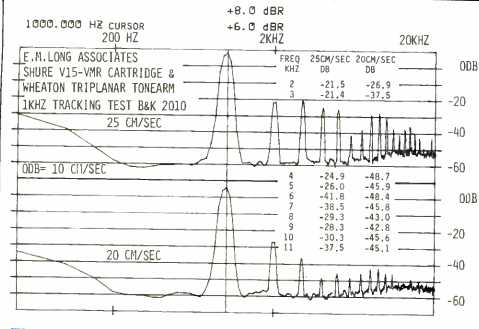
Fig. 11--Spectrum due to output shown in Fig. 10. Distortion at third harmonic
is -43.5 dB or 0.67% at 20 cm/S. At 25 cm/S, the third harmonic is-29.4 dB
or 3.4%, which is excellent for this high-level band of the B & K 2010
test record.
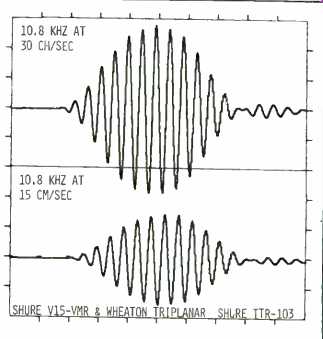
Fig. 12--Response to 10.8-kHz pulse on Shure TTR-103 test record. No compression
is evident even at the 30-cm/S level, which is excellent.

Fig. 13--Spectrum analysis for tone burst of Fig. 12. At the 30-cm/S level
(8 dB above the reference level of 10 cm/S), distortion at 250 Hz is only
1.1%, which is quite good.
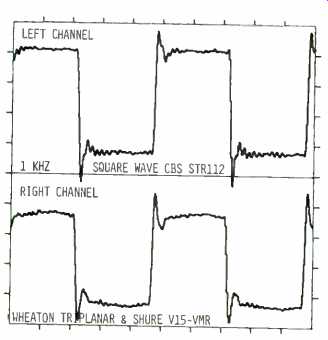
Fig. 14--Response to 1-kHz square wave on CBS STR-112 test record. Good
performance is evident, although the Shure cartridge rolls off frequencies
above 20 kHz.
The very good tracking capability of the Wheaton/Shure combination is indicated in Fig. 10. Even at the 25-cm/S level (the highest level on the test record), the stylus still maintains contact with the groove walls, albeit with higher distortion than at the 20-cm/S level. The spectral content of the distortion is shown in Fig. 11. The distortion is very low for the 20-cm/S level, but there are increases in output for the third, fourth, fifth, eighth, ninth, and tenth harmonics. The increase in output of the higher harmonics would tend to brighten the sound of high-level passages, and this was confirmed by the listening panel's comments. Herbert Papier has made improvements in the Tri-Planar II's bearings to improve its tracking capability, and he sent me another tonearm to check. I received this version too late to have the panel listen to it, but I did evaluate it. Although I don't like to rely solely on my own opinion, I can say that I noticed an improvement in the tonearm's tracking capability.
Figure 12 shows the output versus time for a tone burst test at 10.8 kHz. It indicates excellent tracking for high levels at high frequencies. Poor performance in this regard would tend to impart a leaden quality to the sound of bells, triangles, and cymbals, but comments by the panel indicated that the opposite was true for these instruments when reproduced by the Wheaton/Shure combination. The spectrum of the output versus frequency for this test signal is shown in Fig. 13; it represents excellent performance.
The square wave in Fig. 14 is indicative of good performance, but it also shows that high frequencies, above 20 kHz, are rolled off by the Shure phono cartridge. This correlates well with the amplitude versus frequency response shown in Fig. 1.
Conclusion
If you zipped right to this point of the report to find out who was vanquished, it wasn't the Wheaton Tri-Planar II/Shure V15 Type V-MR combination! This pairing gave the reference system a real contest and actually won many of the rounds. It reproduced certain types of music a little better than the reference system and some a little worse (but you will have to read the report to find out which). With regard to such stereo characteristics as spaciousness and image location, the Wheaton/Shure combination is as good as any I have tested-and better than most.
-Edward M. Long
(Source: Audio magazine, Jun. 1988)
Also see:
Luxman PD-375 Turntable (July 1982)
Visonik Model DD-8200 Turntable (May 1979)
= = = =